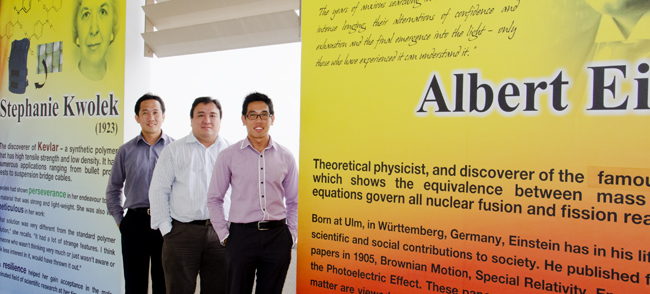Why Singapore’s English Teachers Should Embrace Singlish, Not Fight It
Is it time for Singaporean educators to embrace Singlish as a legitimate learning tool? What the Research […]
Read More
In every school, there will be a number of students who are not interested in studying Science. How do we make Science more engaging for them? Four secondary school Science teachers decided that this was a curriculum issue worth investigating.
As they reflected on their teaching experiences, Science teachers Kelvin Lim, Ernest Yu, Terence Yeo and Jacqueline Tan found that they faced similar challenges.
So when they had to pick a topic for their curriculum project, they chose to look at how they could refresh the teaching of Science, starting with the design of the curriculum.
This was back in 2011, when they were enrolled in NIE’s Management and Leadership in Schools programme, training to become heads of department (HODs).

“One of the problems we saw was that the teaching of classes was didactic in nature,” says Kelvin, HOD at Pei Hwa Secondary School. They wanted to see what else they could do to inject some life into Science lessons.
Another problem they surfaced was that Science tended to be taught in silos, especially at the secondary level. But this shouldn’t be the case, says Ernest, HOD at Anderson Secondary School.
“You can’t do Science by just Physics, Biology or Chemistry,” he comments. “We need a holistic approach to fuse the three sciences. I’m looking at a more thematic approach, rather than a topic approach.”
This holistic approach affects the curriculum as a whole, rather than just lesson planning. Kelvin spells out what is involved.
“Everything from the planning to the determination of what goes into or comes out of teaching, to designing the assessments that are appropriate, and finally to the activities that go on in the classrooms to bring about that desired outcome. It’s a whole package!”
These four teachers believed that a school-based curriculum could enrich the learning experience for students. But a framework was needed to hold it all together.
They decided on the Understanding by Design (UbD) framework by Wiggins and McTighe. Jacqueline had been using this approach in her own school, Jurong Secondary School, and strongly recommended it.
– Mr Terence Yeo, Queensway Secondary School
Initially hesitant, the rest were soon won over when they saw how a common framework like UbD helped to guide both the planning and implementation of the curriculum.
They felt that UbD provides a systematic approach towards redesigning curriculum that allows you to look at what you want to teach, what you want the students to learn, and finally to decide on the specific activities.
This framework acts as a leveller by putting every teacher on the same page – they know what they are supposed to teach and how to go about teaching it. Though the delivery will vary from teacher to teacher, the content is the same for everyone.
Teachers may ask: Why change the curriculum when the Ministry of Education already provides a comprehensive syllabus to guide teachers?
– Mr Ernest Yu, Anderson Secondary School
“Different schools have different needs, and different students have different needs,” notes Terence, now Vice-Principal of Queensway Secondary School. A school-based curriculum ensures that these different needs are met.
For him, the key outcome of any curriculum is that it makes learning meaningful, and students can see why they are learning the content.
For example, when teaching about forces in Physics, teachers need to consider why students would want to learn this. “In UbD, we think about student outcomes,” he explains. “So students must learn this so that they can learn the bigger picture of how forces interact with each other.”
Ernest has brought all this back to his own school and vouches for its benefits, especially in enriching the learning experience.
“They’re more interested in Science now – you can see it,” he notes. “We can’t measure the effectiveness, but we can see the engagement level. The students are more vocal, more confident. They are asking more questions and better ones.”
Over at Pei Hwa Secondary, Kelvin and his teachers have done likewise. They began redesigning the lower secondary Science curriculum in late 2011. It took a year to rework the curriculum for one level, and they are constantly fine-tuning it.
Whether it’s UbD or any other model, the point is to have a framework to structure the curriculum planning. “I think the strength of all this planning comes through in the enriched learning activities for students,” says Kelvin.

For school-based curriculum development to succeed, “the outcome must be very clear, and it has to be the same for all teachers,” says Ernest. He also stresses the importance of getting key personnel to champion the change.
For teachers who want to redesign the curriculum in their own schools, Kelvin advises starting small, by taking a few topics you think would work together. He also recommends starting with the lower secondary curriculum, where there is more room to manoeuvre.
Terence, however, cautions against merely “taking it from the upper secondary level and ‘pulling’ it down to the lower secondary” when redesigning the curriculum. It will require additional work and it’s not an easy process.
“Most of the teachers know it’s more work, but they see the value in it, because it enriches the learning experience of pupils,” says Kelvin. “You might not see quantitative results, but it’s the student excitement and engagement that will surface.”